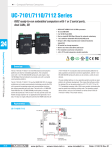Download Moxa EM-1220-LX
Transcript
EM-1220 Hardware User’s Manual Third Edition, January 2010 www.moxa.com/product © 2010 Moxa Inc. All rights reserved. Reproduction without permission is prohibited. EM-1220 Hardware User’s Manual The software described in this manual is furnished under a license agreement and may be used only in accordance with the terms of that agreement. Copyright Notice Copyright © 2010 Moxa Inc. All rights reserved. Reproduction without permission is prohibited. Trademarks MOXA is a registered trademark of Moxa Inc. All other trademarks or registered marks in this manual belong to their respective manufacturers. Disclaimer Information in this document is subject to change without notice and does not represent a commitment on the part of Moxa. Moxa provides this document “as is,” without warranty of any kind, either expressed or implied, including, but not limited to, its particular purpose. Moxa reserves the right to make improvements and/or changes to this manual, or to the products and/or the programs described in this manual, at any time. Information provided in this manual is intended to be accurate and reliable. However, Moxa assumes no responsibility for its use, or for any infringements on the rights of third parties that may result from its use. This product might include unintentional technical or typographical errors. Changes are periodically made to the information herein to correct such errors, and these changes are incorporated into new editions of the publication. Technical Support Contact Information www.moxa.com/support Moxa Americas: Toll-free: 1-888-669-2872 Tel: +1-714-528-6777 Fax: +1-714-528-6778 Moxa China (Shanghai office): Toll-free: 800-820-5036 Tel: +86-21-5258-9955 Fax: +86-10-6872-3958 Moxa Europe: Tel: +49-89-3 70 03 99-0 Fax: +49-89-3 70 03 99-99 Moxa Asia-Pacific: Tel: +886-2-8919-1230 Fax: +886-2-8919-1231 Table of Contents Chapter 1 Introduction ..................................................................................................1-1 Overview.................................................................................................................................. 1-2 Package Checklist .................................................................................................................... 1-2 Product Features ...................................................................................................................... 1-3 EM-1220 Hardware Specifications.......................................................................................... 1-3 EM-1220 Hardware Block Diagram ........................................................................................ 1-4 Appearance .............................................................................................................................. 1-5 Dimensions .............................................................................................................................. 1-6 Chapter 2 EM-1220 Functionality .................................................................................2-1 EM-1220 Embedded Module Functions .................................................................................. 2-2 RS-232/422/485 Serial Ports.................................................................................................... 2-2 Console Port............................................................................................................................. 2-2 LAN Ports................................................................................................................................ 2-2 SD Signals ............................................................................................................................... 2-2 GPIO ........................................................................................................................................ 2-2 Pin Assignments....................................................................................................................... 2-3 Definition of SD Signals.......................................................................................................... 2-4 Mechanical Specifications of the Pin Headers......................................................................... 2-5 Chapter 3 EM-1220-DK Functionality...........................................................................3-1 EM-1220-DK Development Board.......................................................................................... 3-2 Combining the EM-1220-DK with the Embedded Module ..................................................... 3-2 LED Indicators......................................................................................................................... 3-2 Wiring Requirements ............................................................................................................... 3-3 Connecting the Power .............................................................................................................. 3-3 Grounding the EM-1220 Development Kit.............................................................................. 3-4 Serial Ports and Pin Assignments............................................................................................. 3-4 Console Ports and Pin Assignments......................................................................................... 3-5 LAN Ports and Pin Assignments.............................................................................................. 3-5 SD Socket ................................................................................................................................ 3-5 Reset Button............................................................................................................................. 3-5 1 Chapter 1 Introduction Thank you for purchasing the Moxa EM-1220 Embedded Module. The product’s features include 2 software-selectable RS-232/422/485 serial ports, two 10/100 Mbps Ethernet ports, and SD signals for external SD socket connection based on the Moxa ARM9 32-bit 192 MHz communication processor. These features make the EM-1220 ideal for the core module of an industrial embedded system design. The EM-1220 Development Kit, which is designed for system and software program development at the system evaluation stage, is also available. The kit includes the EM-1220 and EM-1220-DK, which is the carrier board used to evaluate the EM-1220. The EM-1220’s pre-installed ready-to-run μClinux Kernel 2.6 makes it easy to develop programs for any application. In this manual, we introduce the hardware features and functions of the EM-1220 Embedded Module and the EM-1220 Development Kit. After a brief introduction to the hardware features, the manual focuses on installation and hardware configuration with device interfaces. The following topics are covered in this chapter: Overview Package Checklist Product Features EM-1220 Hardware Specifications EM-1220 Hardware Block Diagram Appearance Dimensions EM-1220 Hardware User’s Manual Introduction Overview The EM-1220 Embedded Module is designed for system integration and software development in industrial data applications. The module features 2 software-selectable RS-232/422/485 serial ports, two 10/100 Mbps Ethernet ports, and an SD function based on the MOXA ART ARM9 32-bit 192 MHz communication processor. In addition, you may order the EM-1220 Development Kit. The kit includes an EM-1220 embedded module, an EM-1220-DK carrier board, and the items needed for setting up a basic layout. The kit is makes it easy for users to evaluate the functionality of the EM-1220. You can develop and integrate specific systems on the module in advance to make the EM-1220 Embedded Module completely compatible with industrial systems and applications. The pre-installed open Linux operating system makes the EM-1220 suitable for developing the control programs used on a standard PC. The software you develop for your own applications can be stored in the onboard Flash memory. The EM-1220 lets you build an application that has a powerful serial communication capability, but which is still small in size. The EM-1220 is suited for control systems that use a distributed, embedded architecture, such as those systems used for manufacturing automation, intelligent transportation systems, medical management, and data acquisition and control. Package Checklist The EM-1220 package includes the EM-1220 embedded module only. The EM-1220 Development Kit is available for evaluation purposes. The EM-1220 Development Kit package contains the following items: y 1 EM-1220 Embedded Module y 1 EM-1220-DK, the carrier board of the EM-1220 Development Kit y Quick Installation Guide y Document & Software CD y Cross-over Ethernet cable y Console port cable CBL-4PINDB9F-100: 4-pin header to DB9 (female) cable, 100 cm y Universal Power Adaptor y Warranty Statement NOTE: Please notify your sales representative if any of the above items are missing or damaged. 1-2 EM-1220 Hardware User’s Manual Introduction Product Features The EM-1220 Embedded Module has the following features: y MOXA ART ARM9 32-bit 192 MHz processor y On-board 16 MB RAM, 8 MB flash disk y 2 software-selectable RS-232/422/485 serial ports y Dual 10/100 Mbps Ethernet for network redundancy y Ready-to-run μClinux Kernel 2.6 platform y SD signals supported for external SD socket connection y Built-in RTC, buzzer, Watchdog Timer y 10 GPIOs reserved for system integration y Credit card size design for easy integration at any field site y Full-function development kit for quick evaluation and application development y -40 to 75oC wide temperature model available EM-1220 Hardware Specifications Model EM-1220 Embedded Module CPU MOXA ART ARM9 32-bit 192 MHz processor RAM 16 MB Flash 8 MB LAN Auto-sensing 10/100 Mbps × 2 Built-in 1.5 KV magnetic isolation Two serial ports that support RS-232/422/485 signals RS-232 signals: TxD, RxD, DTR, DSR, RTS, CTS, DCD, GND RS-422 signals: TxD+, TxD-, RxD+, RxD-, GND 4-wire RS-485 signals: TxD+, TxD-, RxD+, RxD-, GND 2-wire RS-485 signals: Data+, Data-, GND Serial Ports Serial Protection: 15 KV ESD for all signals Data bits: 5,6,7,8 Stop bit(s): 1,1.5,2 Parity: None, even, odd, space, mark Flow Control: RTC/CTS, XON/XOFF, RS-485 ADDC Speed: 50 bps to 921.6 Kbps, support Any Baudrate Serial Console RS-232 × 1 (TxD, RxD, GND) Storage Expansion SD signals for external Secure Digital (SD) socket connection GPIO GPIO × 10 (to enable GPIO, SD must be disabled.) Real-time Clock Yes Watchdog Timer Yes Buzzer Signals Buzzer signals reserved for external buzzer connection 1-3 EM-1220 Hardware User’s Manual Introduction Signals reserved for the following LED connections: LED Signals System: Ready × 1 LAN: 10M/Link × 2, 100M/Link × 2 Serial: TxD × 2, RxD × 2 Reset Signal Signals reserved for external “Reset to Default” button connection Power Input Accepts external 3.3 VDC through pin header Dimensions (W × L) 80 × 50 mm Operating Temperature Storage Temperature Module Interface -10 to 60°C (14 to 141°F), 5 to 95% RH -40 to 75°C (-40 to 167°F) is optional for EM-1220-T model -20 to 80°C (-4 to 176°F), 5 to 95% RH -40 to 85°C (-40 to 185°F) is optional for EM-1220-T model Two 2 × 17 pin-headers; pitch: 2.0 × 2.0 mm EM-1220 Hardware Block Diagram 1-4 EM-1220 Hardware User’s Manual Introduction Appearance EM-1220 Development Kit (EM-1220 Embedded Module attached to the EM-1220-DK, the carrier board of EM-1220 Development Kit) EM-1220 Embedded Module Top View Bottom View MOXA ART ARM9 32-bit Communication Processor J1 J2 onboard Intel NOR Flash 8 MB onboard 16 MB RAM EM-1220 Development Kit 1-5 EM-1220 Hardware User’s Manual Introduction Dimensions EM-1220 Embedded Module 80cm 50cm 1-6 EM-1220 Hardware User’s Manual Introduction EM-1220-DK, Carrier board of EM-1220 Development Kit 1-7 2 Chapter 2 EM-1220 Functionality In this chapter, we explain the basic features of the EM-1220 Embedded Module. The following topics are covered: EM-1220 Embedded Module Functions RS-232/422/485 Serial Ports Console Port LAN Ports SD Signals GPIO Pin Assignments Definition of SD Signals Mechanical Specifications of the Pin Headers EM-1220 Hardware User’s Manual EM-1220 Functionality EM-1220 Embedded Module Functions The EM-1220 Embedded Module is designed to be integrated directly into the user’s system and application. The module has two software-selectable RS-232/422/485 serial ports, dual 10/100 Mbps LAN ports, 1 RS-232 console port, and GPIO/SD signals. In addition, the EM-1220 uses the Moxa ART ARM9 32-bit 192 MHz communication processor, which ensures excellent performance for data transmission. The pre-installed μClinux Kernel 2.6.9 makes it easy for users to develop programs for a variety of applications. The EM-1220 is an ideal solution for manufacturing automation, intelligent transportation monitoring, and remote device control. RS-232/422/485 Serial Ports The EM-1220 Embedded Module has 2 software-selectable RS-232/422/485 serial ports. Pin assignment diagrams are shown in a later section. The ports can be configured by software. Please refer to Software User’s Manual for details. Console Port The EM-1220 Embedded Module has 1 console port for onsite configuration. The port supports TxD, RxD, and GND RS-232 signals. However, it can also be used as a serial port with standard RS-232 interface. Refer to the Software User’s Manual for details. LAN Ports The EM-1220 Embedded Module has 2 10/100 Mbps LAN ports that can be used to set up a redundant Ethernet network for non-stop operation, and the on-board transformer provides 1.5 KV isolation protection. SD Signals The EM-1220 Embedded Module provides SD signals for storage expansion. Designers can use these signals to create an SD socket. Note that you can use a Secure Digital (SD) memory card compliant with the SD 1.0 standard to provide up to 1 GB of additional memory space. However, the SD signals share the same mechanical layout with the GPIO. When you enable the SD signals, the GPIO function will be disabled, and vice versa. GPIO The EM-1220 Embedded Module provides 10 software-selectable GPIOs. Note that users can choose to enable either the SD Signals or the GPIO function, but not both. When you enable the GPIO function, the SD Signals will be disabled. 2-2 EM-1220 Hardware User’s Manual EM-1220 Functionality Pin Assignments There are two 34-pin pin headers on the EM-1220 embedded module. To use the EM-1220 Embedded Module to develop your own independent system, refer to the following tables for the pin assignments of jumpers J1 and J2. JP1 J1 J2 onboard Intel NOR Flash 8 MB Signals VCC(3.3V) VCC(3.3V) GND GND TxD0 (RS-232) RTS0 DTR0 RxD1 (RS-232) CTS1 DSR1 DCD1 Data-(A)0 / RxD-(A)0 Data+(B)0 / RxD+(B)0 Serial LED_Tx0 Serial LED_Tx1 TxD-(A)0 TxD+(B)0 JP2 2 J1 Pin No. 1 2 3 4 5 6 7 8 9 10 11 12 13 14 15 16 17 18 19 20 21 22 23 24 25 26 27 28 29 30 31 32 33 34 2-3 1 2 Signals VCC(3.3V) VCC(3.3V) GND GND RxD0 (RS-232) CTS0 DSR0 DCD0 TxD1 (RS-232) RTS1 DTR1 Data-(A)1 / RxD-(A)1 Data+(B)1 / RxD-(A)1 Serial LED_Rx0 Serial LED_Rx1 TxD-(A)1 TxD+(B)1 1 EM-1220 Hardware User’s Manual Signals Console_RxD Eth1_TxD_out+ Eth1_TxD_outEth1_LED_100M Eth0_TxD_out+ Eth0_TxD_outEth0_LED_100M GPIO0 GPIO2 GPIO4 GPIO6 GPIO8 Buzzer LED_Ready SDA GND GND EM-1220 Functionality J2 Pin No. 1 2 3 4 5 6 7 8 9 10 11 12 13 14 15 16 17 18 19 20 21 22 23 24 25 26 27 28 29 30 31 32 33 34 Signals Console_TxD GND Eth1_RxD_in+ Eth1_RxD_inEth1_LED_10M Eth0_RxD_in+ Eth0_RxD_inEth0_LED_10M GPIO1 GPIO3 GPIO5 GPIO7 GPIO9 SW Reset SCL GND GND Definition of SD Signals The following table gives the definition of the SD signals. Note that the signal pins from the J2 pin header share the same pin as the GPIO. Signal Name SD_CLK SD_CMD SD_DAT<3:0> SD_CD SD_WP Direction Output Bidirectional Bidirectional Input Input GPIO GPIO 7 GPIO 2 GPIO <6:3> GPIO 1 GPIO 0 2-4 Description Clock signal to SD/MMC Bidirectional line for command and response Bidirectional line for read and write data Card detect Write protect EM-1220 Hardware User’s Manual EM-1220 Functionality Mechanical Specifications of the Pin Headers Refer to the following figures for the mechanical specifications of the Pin Headers on the EM-1220 Embedded Module. The figures define the mechanical specifications of jumpers J1 and J2 on the EM-1220. 2-5 3 Chapter 3 EM-1220-DK Functionality This chapter includes information about the EM-1220-DK (carrier board of the EM-1220 Development Kit). This chapter covers the following topics: EM-1220-DK Development Board Combining the EM-1220-DK with the Embedded Module LED Indicators Wiring Requirements Connecting the Power Grounding the EM-1220 Development Kit Serial Ports and Pin Assignments Console Ports and Pin Assignments LAN Ports and Pin Assignments SD Socket Reset Button EM-1220 Hardware User’s Manual EM-1220-DK Functionality EM-1220-DK Development Board The EM-1220 Development Kit is a well-designed PCB board with complete layout. The kit helps users evaluate, develop, and integrate the EM-1220 Embedded Module into their systems and applications. Simply combine the EM-1220 Embedded Module with the Development Kit to start porting the relevant software, and create a solution for the applications you wish to implement. Refer to the following picture for the basic layout of the EM-1220-DK. Combining the EM-1220-DK with the Embedded Module Insert the EM-1220 Embedded Module vertically onto the EM-1220-DK. Note that the Pin marked “J1” on the Embedded Module must be matched with the Pin marked “J1” on the EM-1220-DK; and the Pin marked “J2” on the Embedded Module must be matched with the Pin marked “J2” on the EM-1220-DK. Be careful when installing the board to avoid damaging the pins. LED Indicators The following table explains the function of the LED indicators located on the EM-1220-DK. LED Name Ready P1, P2 (Tx) P1, P2 (Rx) LED Color LED Function Green Power is on and system functions normally. Green Serial port 1, 2 is transmitting data. Off Serial port 1, 2 is not transmitting data. Yellow Serial port 1, 2 is receiving data. Off Serial port 1, 2 is not receiving data. 3-2 EM-1220 Hardware User’s Manual EM-1220-DK Functionality Wiring Requirements This section describes how to connect the EM-1220 Development Kit to serial devices. You should heed the following common safety precautions before proceeding with the installation of any electronic device: y Use separate paths to route wiring for power and devices. If power wiring and device wiring paths must cross, make sure the wires are perpendicular at the intersection point. NOTE: Do not run signal or communication wiring and power wiring in the same wire conduit. To avoid interference, wires with different signal characteristics should be routed separately. y Use the type of signal transmitted through a wire to determine which wires should be kept separate. The rule of thumb is that wiring that shares similar electrical characteristics can be bundled together. y Keep input wiring and output wiring separate. y It is advisable to label the wiring to all devices in the system. Be sure to disconnect the power cord before installing and/or wiring your EM-1220 Development Kit. ATTENTION Safety First! Be sure to disconnect the power cord before installing and/or wiring your EM-1220 Development Kit. Wiring Caution! Calculate the maximum possible current in each power wire and common wire. Observe all electrical codes dictating the maximum current allowable for each wire size. If the current goes above the maximum ratings, the wiring could overheat, causing serious damage to your equipment. Temperature Caution! Be careful when handling the EM-1220 Development Kit. When plugged in, the EM-1220 Development Kit’s internal components generate heat, and consequently the outer casing may feel hot to the touch. Connecting the Power You may use the 3-pin terminal block for connecting the power. The power input range of the EM-1220-DK is from 12 to 48 VDC. If the power is properly supplied, the “Ready” LED will glow a solid green after a 25 to 30 second delay. 3-3 EM-1220 Hardware User’s Manual EM-1220-DK Functionality Grounding the EM-1220 Development Kit Grounding and wire routing help limit the effects of noise due to electromagnetic interference (EMI). Run the ground wire from the ground screw to the grounding surface prior to connecting devices. ATTENTION This product should be mounted to a well-grounded mounting surface such as a metal panel. SG V- SG: The Shielded Ground (sometimes called Protected Ground) contact is the left most contact of the 3-pin power terminal block connector when viewed from the angle shown here. Connect the SG wire to an appropriate grounded metal surface. V+ 12-48V Serial Ports and Pin Assignments The EM-1220 Development Kit has 2 software-selectable serial ports. If you would like to connect to a serial device, use male DB9 connectors. The ports can be configured for RS-232, RS-422, or RS-485 by software. Refer to the Software User’s Manual for details. Pay attention to the cable length for the various serial communication standards. Refer to the following figure for the pin assignments of the DB9 connector. Male DB9 Port 1 2 3 4 5 6 7 8 9 Pin RS-232 RS-422 1 2 3 4 5 6 7 8 DCD RxD TxD DTR GND DSR RTS CTS TxDA(-) TxDB(+) RxDB(+) RxDA(-) GND ------- 3-4 4-wire RS-485 TxDA(-) TxDB(+) RxDB(+) RxDA(-) GND ------- 2-wire RS-485 ----DataB(+) DataA(-) GND ------- EM-1220 Hardware User’s Manual EM-1220-DK Functionality Console Ports and Pin Assignments The serial console port on the EM-1220-DK is a 4-pin pin-header RS-232 port, which support TxD, RxD, and GND signals. It is designed for serial console terminals, which can be used for local configuration and identifying the EM-1220-LX boot up message. The pinouts of this RS-232 console port are shown in the figure below. Serial Console Port & Pinouts Pin 1 2 3 4 4 3 2 1 Serial Console Cable Signal TxD RxD NC GND LAN Ports and Pin Assignments The EM-1220 Development Kit has two 10/100 Mbps LAN ports. Connect one end of the Ethernet cable to the Development Kit LAN port and the other end of the cable to the Ethernet network. The LAN ports use 8-pin RJ45 connectors. See the following diagram for the pinouts. 8-pin RJ45 1 8 1 8 Pin 1 2 3 4 5 6 7 8 Signal ETx+ ETxERx+ ----ERx----- SD Socket The EM-1220 Development Kit provides an internal SD socket for storage expansion. The socket allows users to use a Secure Digital (SD) memory card compliant with the SD 1.0 standard for adding up to 1 GB of additional memory space. Plug the SD card directly into the socket. Remember to press the SD card first if you want to remove it. Note that the SD will not work if you enable the GPIO function. Refer to the section about the EM-1220’s SD function to see a table that describes the SD card interface. Reset Button Press the Reset button on the EM-1220-DK continuously for at least 5 seconds to load the factory default configuration. After the factory default configuration has been loaded, the system will reboot automatically. We recommend that you only use this function if the software is not working properly and you want to load factory default settings. To reset an embedded Linux system, always use the software reboot command />reboot to protect the integrity of data being transmitted or processed. The Reset button is not designed to hard reboot the EM-1220 Development Kit. 3-5

































